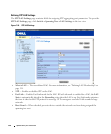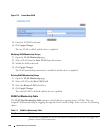
Update with your book title 125
Figure 7-19. Rapid Spanning Tree (RSTP)
•
Interface
— Port or LAG on which Rapid STP is enabled.
•
Role
— The port role assigned by the STP algorithm in order to provide to STP paths. The possible
field values are:
–
Root
— Provides the lowest cost path to forward packets to root device.
–
Designated
— The port or LAG via which the designated device is attached to the LAN.
–
Alternate
— Provides an alternate path to the root device from the root interface.
–
Backup
— Provides a backup path to the designated port path toward the Spanning Tree leaves.
Backup ports occur only when two ports are connected in a loop. Backup ports also occur when a
LAN has two or more connections connected to a shared segment.
–
Disabled
— The port is not participating in the Spanning Tree (the port’s link is down).
•
Mode
— Displays the STP mode by which STP is enabled on the device. The possible field values are:
–
Classic STP
— Enables Classic STP on the device. This is the default value.
–
Rapid STP
— Enables Rapid STP on the device.
•
Multiple STP
— Enables Multiple STP on the device.
•
Fast Link Operational Status
— Indicates if Fast Link is enabled or disabled for the port or LAG. If
Fast Link is enabled for a port, the port is automatically placed in the forwarding state.
•
Point-to-Point Admin Status
— Indicates whether a point-to-point link is established on the port.
Ports defined as Full Duplex are considered Point-to-Point port links. The possible field values are:
–
Enable
— Enables the device to establish point-to-point links.


















